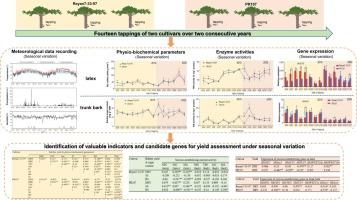Seasonal variation in rubber yield, physio-biochemical parameters and sucrose metabolism-related genes in two rubber tree cultivars
IF 6.2
1区 农林科学
Q1 AGRICULTURAL ENGINEERING
引用次数: 0
Abstract
Sucrose metabolism is essential for the biosynthesis of natural rubber in the para rubber tree (Hevea brasiliensis), but its seasonal regulation remains poorly understood. Here, over a two-year period, we conducted a comprehensive investigation of seasonal fluctuations in rubber yield, physio-biochemical parameters, and sucrose metabolism-related genes in high-yielding Reyan7–33–97 and low-yielding PR107 rubber tree cultivars. Our results showed that rainfall exerted a stronger influence on seasonal rubber yield fluctuations than temperature, and that Reyan7–33–97 was more sensitive to rainfall variation. Comparative analyses uncovered distinct seasonal patterns in sucrose metabolism-related physiological, biochemical, and molecular parameters in both latex and trunk bark tissues, which likely underlie the yield divergence between the two cultivars. Of the 15 physio-biochemical parameters examined, latex dry rubber content (DRC), latex inorganic phosphate (Pi), and latex sucrose synthase activity in the cleavage direction (SSC) were significantly positively correlated with yield, whereas bark reducing sugar (RS) showed a significant negative correlation. These four parameters may thus serve as reliable indicators for rubber yield prediction under fluctuating seasonal conditions. Moreover, the expression levels of several sucrose metabolism-related genes also exhibited associations with rubber yield. Among them, HbSus3 emerged as a key candidate for evaluating yield variations in rubber tree cultivars. These findings deepen our understanding of seasonally regulated rubber biosynthesis and provide valuable indicators for yield assessment under seasonal variation, as well as candidate genes for breeding high-yield rubber trees.

两个橡胶树品种橡胶产量、生理生化参数及蔗糖代谢相关基因的季节变化
在准橡胶树(巴西橡胶树)中,蔗糖代谢对天然橡胶的生物合成是必不可少的,但其季节性调节尚不清楚。在2年多的时间里,我们对高产热研7 - 33 - 97和低产PR107橡胶树品种的橡胶产量、生理生化参数和蔗糖代谢相关基因的季节波动进行了全面的研究。结果表明,降雨对橡胶产量季节性波动的影响强于温度,热岩7 - 33 - 97对降雨变化更为敏感。对比分析揭示了乳胶和树干树皮组织中蔗糖代谢相关的生理、生化和分子参数的不同季节模式,这可能是两个品种产量差异的基础。在15个理化指标中,乳胶干胶含量(DRC)、乳胶无机磷酸盐(Pi)和乳胶蔗糖合成酶裂解方向活性(SSC)与产量呈显著正相关,而树皮还原糖(RS)与产量呈显著负相关。这四个参数可以作为季节性波动条件下橡胶产量预测的可靠指标。此外,蔗糖代谢相关基因的表达水平也与橡胶产量相关。其中,HbSus3成为评价橡胶树品种产量变化的关键候选基因。这些发现加深了我们对橡胶生物合成季节性调控的认识,并为季节变化下的产量评估提供了有价值的指标,为选育高产橡胶树提供了候选基因。
本文章由计算机程序翻译,如有差异,请以英文原文为准。
求助全文
约1分钟内获得全文
求助全文
来源期刊

Industrial Crops and Products
农林科学-农业工程
CiteScore
9.50
自引率
8.50%
发文量
1518
审稿时长
43 days
期刊介绍:
Industrial Crops and Products is an International Journal publishing academic and industrial research on industrial (defined as non-food/non-feed) crops and products. Papers concern both crop-oriented and bio-based materials from crops-oriented research, and should be of interest to an international audience, hypothesis driven, and where comparisons are made statistics performed.
 求助内容:
求助内容: 应助结果提醒方式:
应助结果提醒方式:


